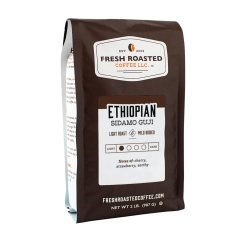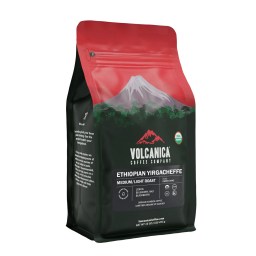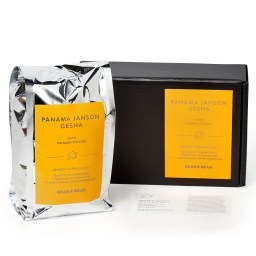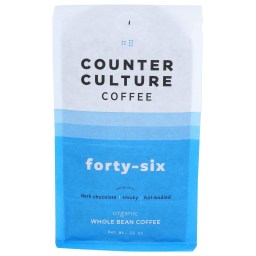Buying guide for Which coffee is best, according to experts?
You probably drink it every day, but finding the best coffee is easier said than done. For starters, there isn't just one coffee that everyone likes best. Coffee preferences are highly subjective.
This can make finding the right coffee difficult, but it’s certainly not impossible. It's all about figuring out what you like, whether that's bright, acidic light-roast beans or a rich, dark roast with intensely chocolatey notes.
That said, factors such as the quality of the beans and how they’re processed can make a big difference when it comes to taste. To learn more, we interviewed two certified Q Graders (also known as sommeliers for coffee), Asser Christensen and Kelly Amoroso, to get their thoughts on what goes into making a fabulous blend.
While we can't tell you which coffee you'd like best, we can point you toward some great options and let your preferences guide the rest. We picked Volcanica Ethiopian Yirgacheffe as our top coffee, as it's carefully blended and known to be quite a crowd-pleaser.
Our top picks
Product details
Roast: Medium-light | Bean Type: Arabica | Packaging Type: Bag
Get ready to become addicted to this one. Our top pick comes from the Yirgacheffe region of southern Ethiopia, which is known for coffee with distinctly floral, fruity notes. Paired with the medium-light roast and washed processing method, this gives you a pleasantly acidic coffee that may be described as bright or lightly sour. It features delicious flavor notes of lemon, blueberry and blackberry.
We like that you can buy this coffee as whole beans or ground for either drip coffee makers, espresso machines or French press coffee makers. This gives you plenty of grind options if you don't have your own grinder, resulting in a better brew.
All farmers growing coffee in this region are part of the Yirgacheffe Coffee Farmers’ Cooperative Union, which helps ensure fair prices for growers. Plus, the beans are grown to meet the highest USDA Organic standards and have the certification to prove it.
Best everyday coffee
Product details
Roast: Dark | Bean Type: Robusta and Arabica | Packaging Type: Canister
Some of the best coffee brands can be extremely expensive, but sometimes, all you want is a solid medium coffee to get you through the day. While it might not be anything to write home about, Yuban Dark Roast Coffee offers great value and tastes good, too.
A mix of robusta and Arabica beans, it has a bold flavor and is nicely roasted with notes of chocolate and spices. Plus, it comes in a 25-ounce canister for less than $9 — a fair and appealing price.
Best medium roast coffee
Product details
Roast: Medium | Bean Type: Arabica | Packaging Type: Bag
Gesha coffee (or Geisha, as it's sometimes known) is routinely voted as one of the best-tasting coffees around. Gesha beans grown in Panama are regarded highly. They might not be cheap, but if you're looking for something special, it's worth a try.
With a medium roast, this is a balanced coffee with reasonably wide appeal, so it's a good place to start if you're unsure what you like. However, Gesha beans are a rare variety with more subtle and complex notes than many other types of coffee. Expect a floral bouquet with notes of pear, apple, sugar and black tea.
This is a complex coffee that might not be for everyone, but it’s a favorite with coffee connoisseurs. It's best enjoyed as pour-over or drip coffee rather than as espresso or in milky drinks. Bean & Bean champions ethical sourcing and sloth conservation with women-owned farms, eco-conscious practices and Sloth Institute donations, so you can feel good about buying it, too.
Best dark roast coffee
Product details
Roast: Dark | Bean Type: Arabica | Packaging Type: Bag
If you like a full-bodied coffee, this dark-roast blend from Counter Culture is a great pick. It comes from a popular indie coffee brand, so you get the flavors you'd expect from a small roastery with the convenience of being able to pick it up in a grocery store or shipped right to your doorstep on Amazon.
This coffee is a blend of beans from Guatemala and Ethiopia. Some beans are processed using the natural method, and others are processed using the washed method. Washed beans are generally more acidic, whereas natural beans are less acidic, so you get a decent balance. Tasting notes include smoke and dark chocolate.
As a dark roast, this coffee is especially great for making espressos and milky drinks thanks to its richness and bold flavors.
Best light roast coffee
Product details
Roast: Light | Bean Type: Arabica | Packaging Type: Bag
Light-roast coffees retain a lot of the natural brightness and acidity of coffee beans. While the best-tasting coffee is subjective, this is a great option for anyone who wants to give light roasts a try. It's bright and mellow without unpleasant sourness. We like the fruity notes of cherry and strawberry.
This is a single-origin coffee made from Sidamo beans grown in the Guji region of Ethiopia. While many African beans are washed during the processing stage, these go through natural processing, which dials down the acidity somewhat.
We appreciate that this coffee comes in 12-ounce bags that are great for average home use as well as larger 2-pound and 5-pound bags.
Best espresso beans
Product details
Roast: Medium | Bean Type: Arabica | Packaging Type: Bag
If you're looking for the best espresso beans, you’d be hard-pressed to find anything yummier than this blend from the popular Portland-based Stumptown Coffee Roasters. They’re ideal for espresso, whether you want to drink it straight up or make it into a specialty drink, such as a latte or flat white.
It's a medium roast that's well-balanced but mild on the acidity, which is part of what makes it such a good choice for espresso. It has a natural sweetness with notes of dark chocolate and citrus.
We like the complexity of this blend, which is made using beans from three regions: Central and South America, Indonesia and East Africa. Overall, it's a crowd-pleasing choice for espresso, as it's not overwhelmingly strong but still robust enough to hold its own.
How to choose the best coffee, according to experts
Asser Christensen, a journalist and licensed Q grader, and Kelly Amoroso, a certified Q Grader and senior coffee buyer at Whole Foods, are experts when it comes to coffee. Here, they gave us some helpful insights on selecting the best coffee for your needs.
Expert picks
Christensen doesn't think there's just one best coffee brand or blend, but he has a top bean variety. "I have explored this topic in-depth, and if you consider it from a very specific perspective focusing on auction prices, coffee competitions and cupping scores (as given by Q graders like myself), there's always one coffee that stands out: the Geisha coffee from Panama," he says.
So, if you come across decent Geisha beans grown in Panama, they're worth trying. However, it's important to note that beans of this type from different brands vary in flavor based on factors such as roast level and processing method.
Choosing a coffee that’s right for you
There's no such thing as the best coffee
"The term 'best coffee' can be misleading or confusing because what's best isn't necessarily the best for everyone," Christensen said. Coffee is a little like wine in that way — a lot comes down to personal preference. Of course, like wine, there's some low-quality, low-cost coffee that's objectively not great. But among coffee of similar quality, there'll likely be some you love and some you don’t.
"Are we discussing the best coffee for espresso? The best for those who prefer low acidity? Or the best for milk-based drinks? Depending on the answer, I'd recommend different coffees," Christensen said. He goes on to say that most people enjoy coffee that's "more aligned with their usual tastes" than one specific brand or bean variety.
The acidity factor
Part of finding your favorite coffee is learning what you like. Acidity plays a significant role in the flavor profiles of coffee. Some people enjoy high-acidity coffee, finding the brightness pleasant. Others find high-acidity coffees too sour and prefer lower-acidity options with richer flavors. "Coffees with low acidity are surprisingly easy to find once you know what to look for, and they are often cheaper as well," Christensen notes.
Lots of factors impact acidity. According to Christensen, "Acidity can be either enhanced or reduced by combining roast degree, processing method, coffee varietal and growing conditions." He notes that darker roasts typically have less acidity. As such, people who like acidic coffee tend to favor light roasts.
Growing region and processing methods can also affect acidity. "By choosing a coffee from places like Sumatra or Brazil, you're more likely to find a low-acid coffee, as these areas primarily process coffee using the pulped natural method," Christensen notes. "Conversely, coffees processed via washing tend to be more acidic and bright.”
Drink types matter
The right coffee for you might depend on the types of drinks you want to make. Christensen says, "It's a bit of a paradox, but the best coffees for espresso and milk-based drinks usually aren't the same beans that coffee connoisseurs consider the best."
Low-acidity coffees are often seen as desirable by experts, but Christensen believes that darker roasts are particularly suited for espresso and milk-based drinks. He explains, “The concentration of an espresso shot makes acidity more disagreeable compared to, say, when the same coffee is presented as a cup of drip coffee."
So, if you're looking to try a new drip coffee or pour-over, it's worth considering a higher-acidity coffee with a lighter roast. But, if you want to make espressos or flat whites, a richer, darker, lower-acidity coffee is a good bet.
What makes a great coffee?
For Christensen, a great coffee is one that has been grown in optimal conditions, harvested at the right time and processed properly: “A coffee cherry-picked at its ripest will yield a sweeter cup with more intense flavor notes." He adds that the roast is also important. "It must be roasted in a way that brings out its best qualities," he says.
Amoroso agrees: “Light will have more citrus fruit notes; medium, more caramel and milk chocolate notes. Dark will have smoky and sweet notes," she says.
The growing region is another factor to consider. According to Amoroso, coffee from East Africa is “fruit-forward.” Coffee from Central and South America is “chocolate, sweet and balanced.” And Asian Pacific coffee is “rich and full-bodied.”
Amoroso has her own preferences when it comes to coffee. "Three elements I look for in a coffee: sweet, complex, lingering finish," she says.
It all starts with a bean
All coffee is brewed from coffee “beans,” but “bean” in this case actually means the pit or stone of the coffee plant’s cherry. Two common species of coffee plants are valued for their beans: Coffea arabica, which produces the Arabica bean, and Coffea canephora, which produces the robusta bean.
Arabica beans
In general, Arabica beans make the best cup of coffee. Christensen's favorite Geisha plant produces Arabica beans. They are more expensive, however, as the Coffea arabica plant is hard to grow and susceptible to pests and disease.
What’s more, it needs several years to mature before it will produce cherries. Most Arabica beans are grown in South America, particularly Brazil and Colombia, but Africa also produces crops of these valuable beans.
Robusta beans
Africa and Indonesia grow the world’s supply of robusta beans. These harsher and more caffeinated coffee beans cost less than Arabica beans, as the Coffea canephora plant is hardier than the Arabica bush and produces far more cherries at a younger age. Supermarket brands, instant coffees and inexpensive coffees are almost always ground from this type of bean.In terms of flavor, Arabica beans win the prize. They brew a more delicate cup of coffee with slight overtones of berry and a high level of acidity. Robustas have a lot more caffeine — nearly twice as much as Arabica beans — but they also have a stronger, more bitter taste that can be a bit harsh. Still, there are high-quality robustas available, and these beans do make a good cup of espresso.
Where in the world is your coffee from?
Coffee is grown in several places around the world. All of these locations share proximity to the equator, a cool-to-moderate tropical climate, rich soil and, in the case of Arabica beans, a high altitude. While you might assume that a coffee bean from Brazil is no different from a coffee bean from Kenya, subtle taste differences exist depending on where the beans were grown.
- South American coffee beans are generally a little sweeter and less acidic than beans from other parts of the world. They often have notes of chocolate, nuts and spices. However, this can vary between regions. For instance, Ecuadorian beans can be bright with citrus notes, while Brazilian beans are often low in acidity with nutty notes.
- Coffee beans from Africa and the Middle East are often fruity with relatively high acidity, making coffee from these regions bright and punchy.
- Indonesian, Asian and Pacific Island coffee beans are low in acidity, heavy in body and earthy in taste. A dark roast brings out the full flavor of beans from these parts of the world.
- Sumatran coffee is often low-acid due to its washing process, in which more of the flesh of the coffee cherry is preserved. This gives it chocolatey notes with a rich earthiness and creaminess.
What about roast?
Coffee beans require roasting before they can be brewed. Some coffee purists prefer to buy raw beans and do their own roasting, but most people buy pre-roasted beans. The roast greatly influences the flavor profile of the beans. With light roasts, you're primarily tasting the natural flavors from the beans. With darker roasts, many of the additional flavor notes come from the roasting process itself. While different coffee growers and roasters have their own cutoff points for each level of roast, in general, you can use the following guidelines.
- Lightly roasted beans are high in acidity. While this might not sound appealing, acidity can be a prized characteristic in coffee and is often described as brightness. They can be sweeter and less bitter than darker roasts. You’ll generally find the highest levels of caffeine in these beans, though not by much.
- Medium-roast beans are more flavorful, and you can usually taste the bean’s aromatics, such as floral, berry or earthy notes. This is the most common roast for American coffee, perhaps because it offers a balance of richness and rightness.
- Medium-dark roasts give you a rich, dark coffee. You’ll often see a bit of oil on the surface of the coffee. The acidity of the brew is lower, but you may notice a bittersweet aftertaste.
- Dark roasts have a full body, bitter taste and little acidity. However, there's a difference between pleasant coffee bitterness, which generally comes from acid lactones, and unpleasant coffee bitterness from phenylindanes. They're more likely to have nutty and chocolatey notes from the roasting process. Note that a dark roast doesn’t necessarily mean stronger coffee; that depends mostly on how you brew it.
Whole-bean coffee vs. ground coffee
If you are a coffee purist, there’s no argument: Buying whole beans and grinding them yourself is the way to go. You’ll get the freshest cup of coffee this way. Once ground, coffee beans start to oxidize, reducing and altering the flavor.
Grinding your own beans also lets you tailor the grind to your preferred coffee-making method. For espresso, you'll want a fine grind, but if you're brewing in a French press or making a cold brew, you need a more coarse grind. You’ll need a coffee grinder to do your own grinding, however.
If you are all about convenience and aren’t picky, go ahead and buy your beans already ground. Do look for the freshest beans, however; you’ll find a big difference between beans ground a day or two ago and ground beans that have been sitting on the supermarket shelf for months.
Coffee prices
The price of coffee depends on quite a few things, including the brand, roast, variety and whether it has been ground. While you can buy a can of ground coffee at the supermarket for $6 or so, better coffee brands tend to cost anywhere from $9 to $20 per 12-ounce package.
Tips
Once you’ve narrowed down your favorite bean or blend, proper storage will keep it tasting its best.
- Buying in bulk is good for many things, but not coffee beans. As a general rule, only buy as much coffee as you will consume in one week.
- Coffee beans need to “rest” for a few days after being roasted. This allows carbon dioxide, which can alter the flavor, to escape. But beyond that, the fresher, the better. Check the roast date before buying. Preferably, the beans were roasted no more than two weeks earlier; one week is even better.
- If your coffee beans come in a paper bag, transfer them to an airtight jar made of ceramic or another opaque material.
- Store your coffee in a cool, dry pantry. Too much heat or light will quickly spoil the taste.
- Coffee beans that look excessively oily were likely over-roasted. The result is coffee with a burnt flavor. Avoid this if possible.
- Grind beans right before brewing. Only grind the amount of coffee you plan to use that day.
FAQ
Q. How is caffeine removed from decaf coffee?
A. Caffeine is mostly stored in the outer layer of the coffee bean. To remove caffeine, raw beans are steamed and the outer layers scraped away. The beans are dried before they are roasted.
Caffeine removal does affect coffee flavor, which is why decaf coffee can taste slightly flat. Bear in mind that “decaffeinated” coffee doesn’t necessarily have zero caffeine in it. As a general rule, decaf coffee has around 10% of the caffeine found in regular coffee.
Q. What does Fair Trade Certified mean?
A. “Fair Trade Certified” means the farmers were paid a fair wage, no forced or child labor was involved in the growing or picking of the beans, the use of pesticides and other harmful chemicals was limited and the coffee plantation practiced sustainable farming methods.
You’ll find many brands of coffee certified as Fair Trade, particularly specialty brands. The Fair Trade Certified program is an international program run by TransFair USA.
Q. Is it worth paying more for specialty coffee brands?
A. While there’s no need to break your budget for a good cup of joe, premium brands of coffee truly do produce a premium-tasting brew. Specialty coffee growers and sellers generally start with beans of higher-than-average quality. They use the best methods for roasting, they package the beans quickly after roasting them, and they offer a wide variety of bean types, flavored coffees and specialty blends.
Q. Is instant coffee really coffee?
A. While instant coffee does start off as regular brewed coffee, it goes through a process — either freeze-drying or spray-drying — to remove all liquid from the beverage, leaving behind just the powdery remains. While instant coffee is convenient, it’s generally made from inferior-quality beans, and the drying process tends to leave the coffee with a bitter taste.
How we analyzed
We started by interviewing two experts, Amoroso and Christensen, to get insight into what makes a good coffee. Armed with this information, we considered more than 50 coffees before settling on our top choices. We compared them based on factors such as where the beans were grown, how they were processed and how heavily they were roasted.
Our expertise
Lauren Corona has been writing about food and drink since 2010. She's covered coffee and coffee-related products dozens of times. She's serious about coffee and regularly seeks out new beans from third-wave coffee roasteries. You can often find her sitting in a cute café with a good coffee. Having tried hundreds of blends and single-origin beans in her time, both at home and in coffee shops, she has a good idea of what's worth trying and what's best avoided.
Sources
- Interview with Asser Christensen, a licensed Q grader and journalist for Coffee Chronicler
- Interview with Kellly Amoroso, a certified Q Grader and senior coffee and tea buyer at Allegro Coffee Company/Whole Foods Market
- Why is Coffee from Sumatra Famous? Here are 5 Facts, Asser Christensen
- Light Roast vs Dark Roast Coffee: All Differences Explained, Coffee Bros. Roastery
- What’s the Difference Between Light, Medium and Dark Roast Coffee, Methodical Coffee
- Washed, Honey and Natural: The Processing Encyclopedia, Asser Christensen
- Regional Coffee Profile: South America, Queen Bean Coffee Company
- African Coffee Bean: Vivid Flavors From Ethiopia and Kenya, Paulina Palaikyte




























